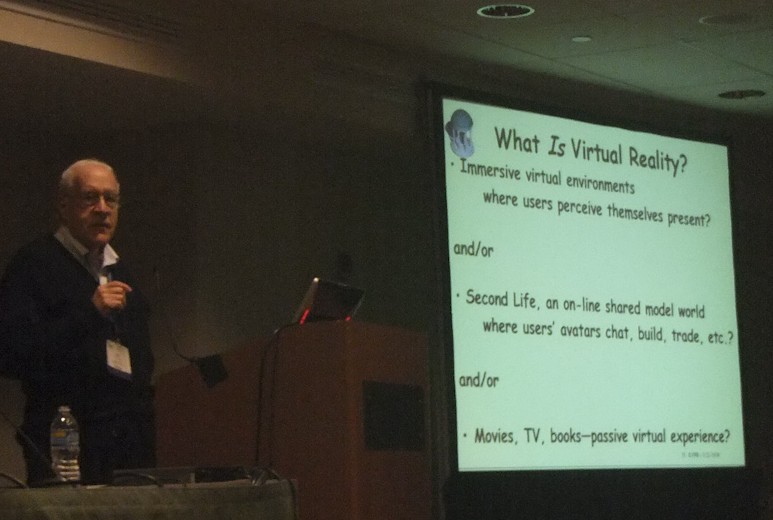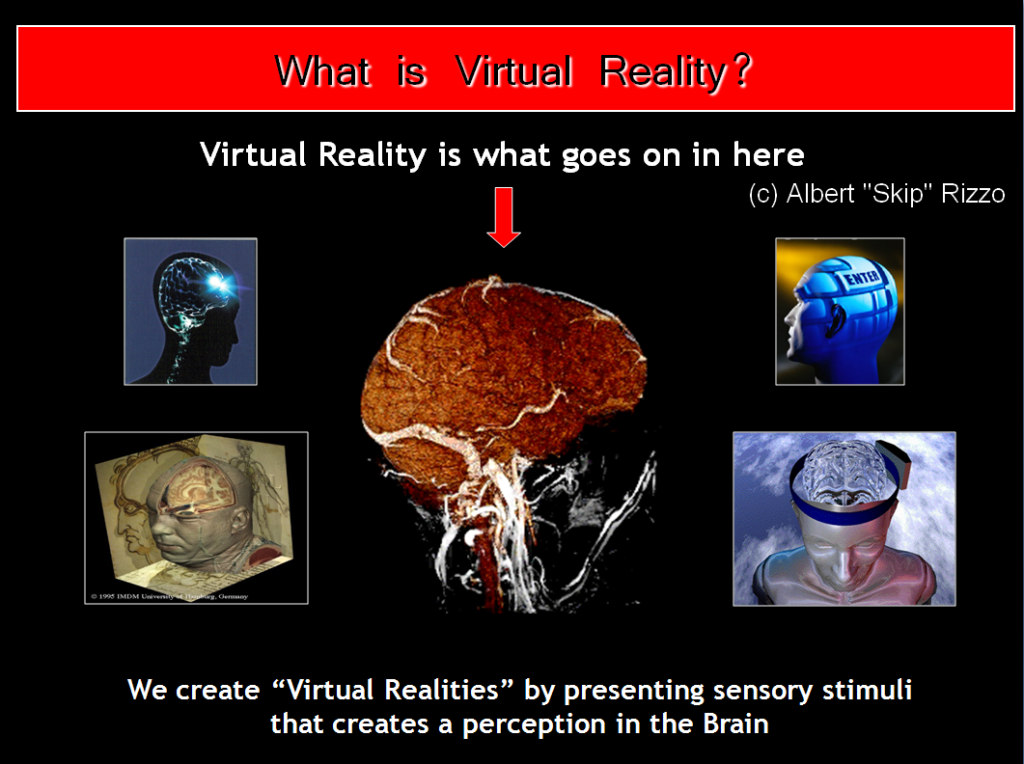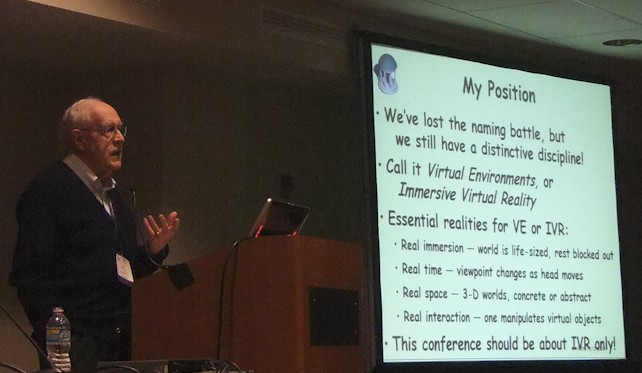Short definition
Immersive Virtual Reality (iVR) is the science and technology required for a user to feel present, via perceptive, cognitive and functional immersion and interaction, in a generated  environment.
Introduction
The term VR, Virtual Reality, seems now useless because it is too broadly defined and means different things to people. It ranges from any kind of 3D interactive application, to online metaverses like SecondLife, and finally to immersive VR.
For me VR is Immersive Virtual Reality, the ultimate alternate reality we can get ! For examples of what I call iVR setups and applications, read my State of VR.
The terms ‘Immersion’ and ‘Presence’, which for me are essential for VR, are also now confusing, so let’s start by defining some fundamental concepts.

– Fred Brooks asking the question, IEEE VR 2010 Â –
Definitions
Reality
We could start be defining reality. Reality is constructed in your brain based on what your senses perceive. In this sense, VR is as real as the reality. We should actually compare natural reality and virtual reality.

Presence
Then let’s define presence. I’ll use the definitions of Mel Slater as described in this article.
Presence means that you are both cognitively and perceptually immersed. Your mind perceives this alternate reality as a coherent reality and accepts it.
The place illusion (PI) implies that your perception is fooled. This means realtime interactions, headtracking, whatever is needed to fool your perception.
The plausibility illusion (Psi) implies that your cognition is fooled. Everything that happens is coherent. You actually believe you’re there, your actions have a credible impact on the virtual environment (VE) and your sensations are affected by it.
PI and Psi are orthogonal, meaning you can have one without the other.
Once you get and maintain both PI and Psi, you are completely involved emotionally, physically and psychologically.
You cannot objectively measure presence, as you can’t measure hunger or happiness. This may be different for everyone. What you can measure is if people respond to this VE as if it is real, which is a result of presence.
Philippe Fuchs adds a third level, above perception and cognition : functional immersion and interaction. You are immersed in the task you’re doing.
Immersion
Immersion is a technical capability of a VR system and nothing else. You can evaluate the immersion level of a system compared to another.
For the moment we can only immerse pseudo-naturally vision, and audition, a bit of the touch (haptics), but the immersion of other senses ( proprioception, olfaction, gustation (taste), vestibular information ) is embryonic at best.
Immersive VR
So for me, VR is defined as anything that contributes to make you feel present (on all levels, not just cognitive)  in a synthetic environment and the study of these factors.  That’s why  a lot of people are now using the term Immersive Virtual Reality, iVR.
This encompasses a lot of things : realtime computer graphics since most of our brain is devoted to visual processing, displays, 3d interactions, 3d sound, haptics, olfactory devices, virtual humans, psychology, neurology, and a lot of other areas.
All these elements can be used separately and are only part of iVR if they help create presence. Haptics, realtime 3d etc can be used for other things than iVR.
Having a 3d tracker doesn’t automatically make your application an iVR application !
Having stereoscopy doesn’t make your application an iVR application !
This excludes a lot of other things : Second Life, QuicktimeVR, books, movies… SecondLife could easily be iVR though.
Once you have presence, you can build on that to live very different experiences.
Books, games, movies ?
I often hear : “I feel very present when I read a book/play a game/watch a movie so according to your definition it must be VR!”.
I think that what applies to desktop systems will also apply to movies and books :
In “Le traité de la Réalité Virtuelle” : ” Having a cognitive activity in a virtual environment without a physical activity (sensori-motor) is outside the boundaries of VR”.
As explained furthermore by Mel Slater : “In the case of a desktop system the situation is quite different, the feeling reported as ‘being there’ if it comes at all is after much greater exposure, requires deliberate attention, and is not automatic – it is not simply a function of how the perceptual system normally works, but is something that essentially needs to be learned (…) PI may still be reported, but this is as a consequence of additional creative mental processing.”

– Mel Slater, IEEE VR 2010 –

– Fred Brooks answering the question, IEEE VR 2010 –
Augmented reality
I’m finally ready to accept that you can feel present through AR, if you believe that the mixed reality created is coherent, that there is no mismatch between the real and the augmented reality (which doesn’t happen so often for the moment..)
Definitions
Here are some other definitions so you can create your own. Also checkout the slides from the “What is VR ?” panel at IEEE VR 2010.
– Sherman and Craig, from “Developping VR Applications” :
“A medium composed of interactive computer simulations that sense the participant’s position and actions, providing synthetic feedback to one or more senses, giving the feeling of being immersed or being present in the simulation”
– David Nahon :
Virtual Reality is a set of technologies and sciences that enables to physically immerse a user within a virtual 3D world by  providing both an enhanced presence of the virtual world for the user (with stereoscopic and view dependant rendering, 3D sound, haptics …)  and an enhanced presence of the user in the virtual world (through direct natural body interactions)

1 Comment